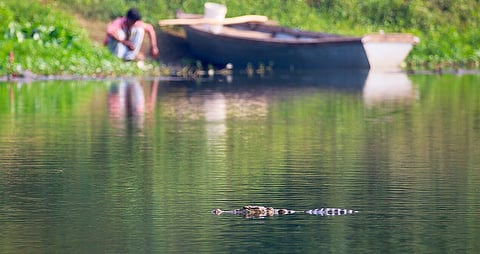

The Vadodara Municipal Corporation (VMC) has decided to temporarily relocate 150 crocodiles to safer locations. This is being done to minimise harm to the animals of the Vishwamitri river which have been apparently been affected due to recent efforts to dredge the river, according to media reports.
The dredging is being done to prevent floods. Vadodara, Gujarat’s third-largest city, was hit by severe floods on August 26 last year. The Vishwamitri burst its banks and many areas were waterlogged till the water began to recede around August 29.
The river, passing through the middle of a city of 3 million people, is home to at least 300 mugger or marsh crocodiles and is usually held up as an example of human-wildlife co-existence.
However, as the VMC seeks to temporarily shift these unique animals, it is not the first time that Gujarat has carried out an operation of such magnitude.
A similar exercise had been conducted a few years ago at the Statue of Unity (SoU) in the middle of the Narmada river in the state’s Narmada district.
On July 5, 2021, the range officer, Kevadia, Vadodara Wildlife Division, Gujarat Forest Department, released a statement informing that 194 mugger crocodiles had been translocated from the SoU, Panchmuli Lake (Dyke 3), Sardar Sarovar Dam (Narmada Dam) area.
The translocation was done to make a seaplane lauchpad for ferrying tourists to the SoU.
So, what became of those crocodiles? Where did they go?
In 2019, when the decision to translocate the crocodiles was first announced, Down To Earth (DTE) had spoken to Raju Vyas, a well-known herpetologist who has studied the crocodiles of the Vadodara region for two decades.
Vyas had then criticised the exercise, calling it non-scientific.
Last year, Vyas had published a paper titled Argument on translocation of marsh crocodiles (Crocodylus palustris) in Gujarat, India in the journal Species, where he discussed what happened to the translocated animals.
As per the range officer’s statement, 143 of the 194 crocodiles were translocated in October-March 2019-20. Of these, 73 were released in the backwaters of the dam side and upper Narmada River.
“In April 2020-March 2021, 51 crocodiles were reportedly moved to facilities at: Indroda Nature Park, Gandhinagar (GEER Foundation); and, Pavagadh Rescue Center, Panchmahal,” Vyas’ paper notes.
“During visits to both rescue facilities in 2022, I noted that the numbers of rescued Muggers and livestock registered data (Central Zoo Authority Inventory of Animals in Indian Zoos) did not match the numbers mentioned in the press release. We were unable to obtain detailed information on morphometrics, gender and capture techniques for Muggers from forest officials and Sardar Sarovar Dam authorities,” the document adds further.
“Some translocated Muggers were kept at Pavagadh Rescue Centre, but this center was not eligible as per CZA guidelines,” it notes.
Vyas, who is currently in the US, told DTE that the latest decision by the VMC has shades of déjà vu.
“Where will these 150 animals be kept? Has nothing been learnt from the earlier instance? No details have been provided about where the animals will be housed, even if temporarily. The Kamatibaug Zoo in Vadodara is already full and has no further space,” he said.
As per the International Union for Conservation of Nature guidelines, translocations should be fully documented and their outcomes made publicly and suitably available to inform future conservation planning.
Moreover, “Any activity that is against the survival of a legally protected species, without having been approved by the State Wildlife Board and National Wildlife Board and the Government of India, is patently illegal. There are established rules, regulations and policies to be followed before attempting to relocate ‘Schedule 1’ species,” the paper adds.